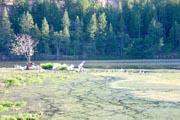http://www.siskiyoudaily.com/articles/2006/09/01/news/doc44f8cbef00fca699280607.txt
Blue-green algae impacts
debated
By TIM RIOS and BRAD SMITH Daily News
Staff Writers September 1, 2006
SISKIYOU COUNTY — Controversy exists over possible
health impacts from contact with the blue-green
algae found in parts of the Klamath River.
Residents of the Copco Lake and Iron Gate
surrounding areas dispute what they say are “news
reports about people and animals getting sick.”
“I can tell you,” said Copco resident Phil
Reynolds, “I’ve lived here 26 years and I’ve never
seen any of those things happen.”
The consensus among the community members at a
recent meeting was that no one in their community
had ever become ill after swimming in the lake or
eating fish from it.
They said that the algae is an annual occurrence
that has been a part of the lake communities for
as far back as they can remember. They avoid it
and, therefore, it’s not an issue, several
residents said.
However, according to U.S. Environmental
Protection Agency senior policy advisor Maria Rey,
the comments from Copco and Irongate residents
cannot be viewed as conclusive evidence that the
algae poses no health risk.

Siskiyou Daily News Photo/Brad Smith - Abour
50 residents of the Copco Lake/Irongate Dam
communities meet to air their views about the
blue-green algae issue. “We appreciate that
sort of oral history,” Rey said. “But the
truth is, there are several different types of
algae.” |

DAILY NEWS PHOTO/BRAD SMITH - Birds nest along
a large blue-green algae bloom along Copco
Lake’s shore. The residents of this community
say that the algae has had no ill effects on
them, their animals or the lake’s fish. |
Rey explained that although the Copco and
Irongate residents say they have seen algae in the
water for years, it is possible that the algae
they’ve seen before is not the species now being
detected in the Klamath.
Recent water sampling performed by the Karuk Tribe
on the Klamath confirmed high levels of a
blue-green algae that could pose health risks, Rey
said.
As part of an ongoing water quality monitoring
program, the EPA funded the Karuk Tribe in spring
of 2005 to conduct additional sampling on the
Klamath, according to Rey.
“We didn’t know anything about the blue-green
algae,” said Karuk Tribe department of natural
resources Klamath campaign coordinator Craig
Tucker. “What we were trying to find out was the
health of the fish.”
The results of those tests found high levels of a
blue-green algae species known as microcystis
aeruginosa in samples taken from Copco Lake and
Irongate Reservoir earlier this summer.
Shortly thereafter, a press release issued by
Siskiyou County Public Health warned of the
possible effects of contact with the algae.
An excerpt reads: “While there have been no
documented cases of human illness associated with
blue-green algae in California, studies around the
world show that recreational exposures to toxic
blue-green algae might result in eye irritation,
allergic skin rash, mouth ulcers, vomiting and
diarrhea, and hay-fever like symptoms.”
Siskiyou County Health Officer Dr. David
Herfindahl explained that while no ill effects are
anticipated from human interraction with the blue
green algae, he felt it was important to publicize
all available health information about the issue.
Terry Barber, the health department’s director of
environmental health, said that animal deaths
reported last year as being related to blue-green
algae blooms did occur – but not in Siskiyou
County.
“That particular press release was about cases
that happened in Humboldt County, and it was a
completely different sort of toxin,” she explained
In the Humboldt County case, dogs that had swum in
the Eel River were dead within 30 minutes.
“But that’s because Anatoxin A was detected in the
Eel River,” said Barber. “Anatoxin A has never
been detected in the Klamath River nor Copco
Lake.”
According to www.cbwinfo.com, a chemical and
biological weapons infomational web site, Anatoxin
A is synthesized by the blue-green alga Anabena
flos-aquae.
Anatoxin-A binds to receptors that receive the
acetylcholine impulses from nerve ending. When the
chest muscles responsible for breathing are
affected, overstimulation of the muscles leads to
limb paralysis and death.
Barber said that there have been no recorded cases
of human or animal iillness or death from contact
with blue green algae in Siskiyou County.
Tucker confirmed that he did not know of any cases
reported of sickness due to blue-green algae found
in the Klamath.
But the Yurok and Karuk tribes are voicing
concern, they say, because their lifestyle is
widely connected to the river.
“We swim in the water, we fish in the water,” said
Karuk vice-chairman Leaf Hillman. “We want to make
sure our people are safe.”
In addition to the results found in Copco and
Irongate in July, toxins were detected in the
lower Klamath on July 26, according to Ken Fetcho,
the Yurok Tribe environmental program water
division assistant director.
“Low levels of the microsystin were detected
during our routine monthly tests,” Fetcho said.
The species of blue-green algae known as
microcystis aeruginosa produces a toxin known as
microsystin.
In essence, Fetcho said, the toxin produced by the
algae cells was detected before the blooms
themselves were.
Copco and Irongate residents also confirmed that
no animals have died as a result of the algae.
They said that theirs is a “thriving ecosystem.”
“I have no fear putting my kids in the water,”
said Irongate resident K.C. Walden.
The residents questionned the method and location
of the samples taken.
Several said that they witnessed samples being
taken only along the shores where the algae growth
is most profuse.
“Were any deep samples taken in the middle of the
lake?” one resident asked.
The answer to that question, according to Rey, is
yes.
She confirmed that sample locations, including
along the shores where swimmers might come in
contact with the algae, as well as mid-reservoir
to test deeper waters, were tested evenly.
Rey also said that the sampling techniques and
protocols used by the Karuk Tribe met the EPA’s
quality assurance and quality control standards.
“The samples collected this July showed levels of
microcystis aeruginosa more than double the
highest level recorded last August along the
shoreline,” said Jacob Kann, Ph.D., a water
quality specialist who reported on the sampling
conducted by the Karuk and Yurok Tribes.
“The recent July levels exceed the World Health
Organization standard for moderate probability of
adverse health effects by over 3,900 times,” he
said.
Kann goes on to say, “Microcystin toxin produced
by the blooms in one location was 2813
micrograms/liter. That measurement is also the
highest recorded to date and exceeds the WHO
guideline of 20 micrograms/liter by as much as 140
times.”
“The studies of human interaction with blue-green
algae blooms are very limited,” Barber said.
She added that there “aren’t standardized tests
per se.”
Barber said that the most common methods used were
enzyme-linked immunosorbent assay (ELISA) and mass
spectrometry.
Studies getting underway in Florida and Michigan,
wherein scientists and doctors will be working
with volunteers, will be closely followed by the
Siskiyou County Health Department.
“We’re going to monitor their efforts,
step-by-step,” Barber said.
“In a sense, this is new territory for everyone
involved.”
The EPA stands by its numbers and urges the public
to take steps to avoid contact with the algae.
“We do see this as a serious risk,” Rey said. “The
recent samples are the highest in the continental
U.S. at this time.”
|

